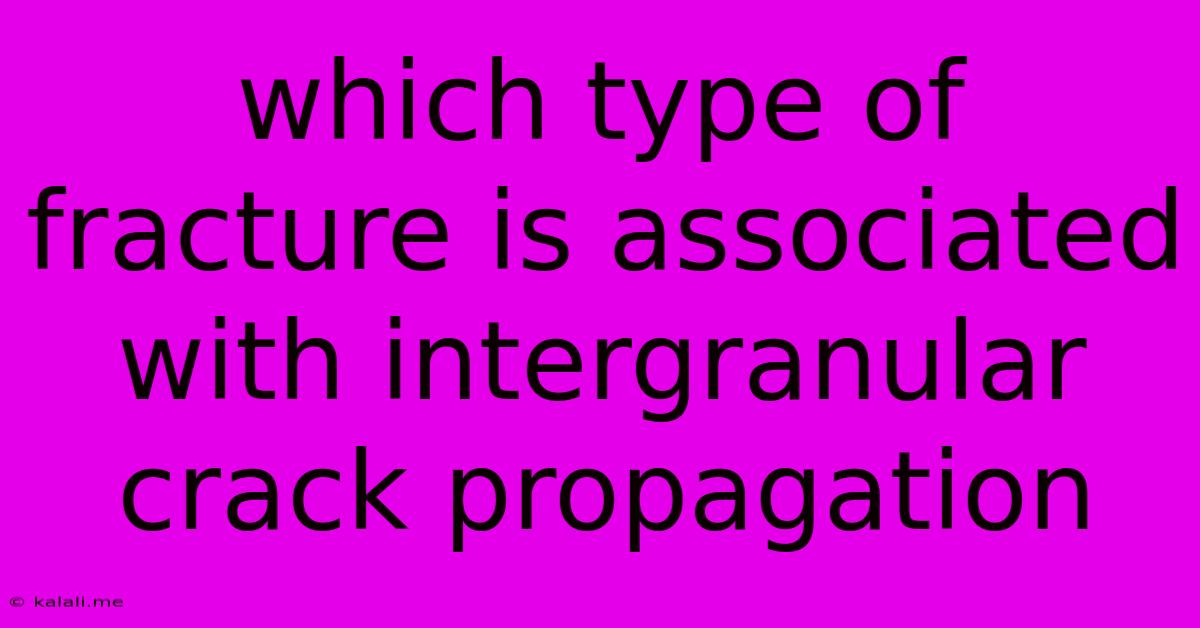Which Type Of Fracture Is Associated With Intergranular Crack Propagation
Kalali
Jun 15, 2025 · 3 min read

Table of Contents
Intergranular Crack Propagation: Understanding the Fracture Type
Intergranular crack propagation, a specific type of fracture mechanism, is strongly associated with creep fracture and stress corrosion cracking. Understanding this crucial distinction is vital for material scientists, engineers, and anyone involved in material selection and failure analysis. This article delves into the details of intergranular crack propagation, highlighting the fracture types where it's most prevalent and the underlying causes.
What is Intergranular Crack Propagation?
Intergranular crack propagation refers to the process where a crack advances along the grain boundaries of a polycrystalline material. This is in contrast to transgranular crack propagation, where the crack travels through the grains themselves. The difference is significant because grain boundaries often possess different properties than the grains themselves, including weaker bonding, higher impurity concentration, and different crystallographic orientations. This makes grain boundaries preferential pathways for crack propagation under certain conditions.
Fracture Types Associated with Intergranular Crack Propagation:
Several fracture types are characterized by intergranular crack propagation. The most prominent are:
1. Creep Fracture:
Creep fracture is a time-dependent fracture process that occurs under sustained stress at elevated temperatures. At high temperatures, grain boundary diffusion becomes significant, leading to the formation of cavities and cracks along the grain boundaries. These cavities coalesce, forming larger cracks that eventually lead to fracture. The slow, progressive nature of creep contributes to the characteristic intergranular crack propagation. Identifying creep fracture often involves examining the microstructure for evidence of cavitation and intergranular cracking. The morphology of the fracture surface, often exhibiting a dimpled or faceted appearance, also provides valuable clues. Factors like temperature, stress levels, and material composition play significant roles in creep fracture initiation and propagation.
2. Stress Corrosion Cracking (SCC):
Stress corrosion cracking occurs when a material is subjected to a corrosive environment and tensile stress simultaneously. The corrosive environment preferentially attacks the grain boundaries, weakening them and promoting crack initiation and propagation along these boundaries. The intergranular nature of SCC is often dependent on the specific material and the corrosive environment. Understanding the electrochemical processes involved is crucial in understanding and mitigating SCC. For instance, the susceptibility of stainless steels to chloride-induced SCC is well-documented, highlighting the importance of considering environmental factors.
3. Liquid Metal Embrittlement (LME):
While less common than creep and SCC, liquid metal embrittlement (LME) also exhibits intergranular crack propagation. In LME, the presence of a liquid metal reduces the fracture strength of a solid material, leading to brittle fracture. The liquid metal penetrates the grain boundaries, reducing the cohesive strength and accelerating crack propagation. This process is highly dependent on the specific combination of liquid metal and solid material.
Other Factors Influencing Intergranular Crack Propagation:
Beyond the primary fracture types, several other factors can influence intergranular crack propagation:
- Grain boundary segregation: The accumulation of impurities or alloying elements at grain boundaries weakens them, making them more susceptible to cracking.
- Grain size: Materials with larger grain sizes generally exhibit more intergranular fracture because of the increased area of grain boundaries.
- Heat treatment: Improper heat treatment can lead to grain boundary embrittlement and increase susceptibility to intergranular crack propagation.
Conclusion:
Intergranular crack propagation is a critical aspect of material failure analysis. Understanding the underlying mechanisms and associated fracture types – primarily creep fracture and stress corrosion cracking – is essential for engineers and material scientists to design and select materials that exhibit enhanced resistance to failure. Detailed analysis of microstructure, fracture surface morphology, and environmental conditions is necessary to pinpoint the cause of failure when intergranular cracking is observed. Further research continues to refine our understanding of this complex phenomenon and improve material performance in demanding applications.
Latest Posts
Latest Posts
-
Is A Speaker An Input Device
Jun 16, 2025
-
Sound Travels Fastest In Which Medium
Jun 16, 2025
-
2 Elements That Are Liquid At Room Temperature
Jun 16, 2025
-
What Is The Greatest Angle Measure In The Diagram
Jun 16, 2025
-
Lowest Common Multiple Of 3 5 And 9
Jun 16, 2025
Related Post
Thank you for visiting our website which covers about Which Type Of Fracture Is Associated With Intergranular Crack Propagation . We hope the information provided has been useful to you. Feel free to contact us if you have any questions or need further assistance. See you next time and don't miss to bookmark.